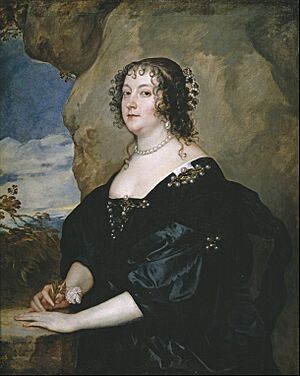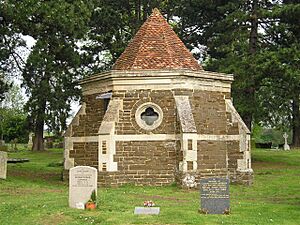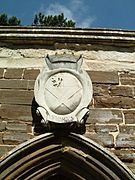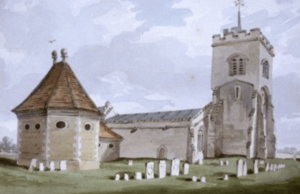Ailesbury Mausoleum facts for kids

The Ailesbury Mausoleum is a special building in the churchyard of St Mary's Church in Maulden, Bedfordshire. It is a Grade II listed structure, meaning it's an important historical building. It was built in 1656 by Thomas Bruce, 1st Earl of Elgin (1599–1663). He built it to house the coffin and a beautiful monument for his second wife, Lady Diana Cecil (who died in 1654). She was the daughter of William Cecil, 2nd Earl of Exeter.
According to a historian named Sir Howard Colvin, this mausoleum is one of the first two stand-alone mausoleums ever built in England. A mausoleum is a building that acts as a tomb or a monument for someone who has died.
Contents
History of the Mausoleum
Why Build a Mausoleum?
Before mausoleums became common in England, important families usually buried their loved ones inside churches. They would often be buried in the church they supported or where their family's main home was located.
In older times, very wealthy people sometimes built their own abbeys or monasteries. They wanted to be buried there so monks or nuns could pray for their souls. If someone was very important, they might even be buried in a cathedral. The most honored spot was usually near the altar in the chancel (the area around the altar).
How the Mausoleum Was Built
The right to choose the priest for Maulden church was bought in 1635 by Thomas Bruce, 1st Earl of Elgin. He had been given the nearby Houghton House by King James I. This house became his family's main home. The Bruce family kept control of the church until 1954.
The Ailesbury Mausoleum originally had two parts. There was an underground crypt with a vaulted ceiling. Above ground, there was an octagonal room. The crypt held the Countess's coffin. The room above showed her monument. This monument was a white marble sculpture of the Countess, often called "the lady in the punchbowl".
The room had oval windows to let in light. A short covered walkway connected the mausoleum to the north side of the church. This led to the family's special seating area in the church. An old painting from the early 1800s shows how it looked back then. It also shows the unique roof with different types of clay tiles, which you can still see today.
Changes Over Time
Family Connections and New Burials
After the 1st Earl of Elgin died in 1663, his son, Robert Bruce, 1st Earl of Ailesbury, added more to the mausoleum. He placed white marble busts (sculptures of heads and shoulders) of his father and his own son, Edward Bruce, inside. These were put in special niches on either side of the Countess's monument. Their coffins were placed in the crypt below.
Later, Thomas Bruce, 2nd Earl of Ailesbury (1656-1741) was a strong supporter of the Stuarts. He left England in 1696 because of his loyalty to King James II. He never returned to Houghton House. In 1738, he sold the house. However, the family still cared about the Mausoleum.
The family's main home moved to Tottenham Lodge in Wiltshire. This happened when Charles Bruce, 3rd Earl of Ailesbury inherited other family estates. Even though they moved, they kept a strong connection to the Mausoleum.
In 1746, the Earldom of Ailesbury was about to end because Charles Bruce had no son. So, he asked the king to create a new title for his nephew, Thomas Brudenell. This new title was Baron Bruce of Tottenham. Thomas Brudenell also inherited the family estates and took on the Bruce surname.
In 1776, King George III made Thomas Brudenell-Bruce the Earl of Ailesbury. The coffins in the crypt had become very old. So, in 1769, Thomas Brudenell-Bruce ordered special compartments called loculi to be built. These were to re-house the old coffins and hold future family members. The family continued to use the Mausoleum for burials until 1836. By then, 24 of the compartments were filled.
A New Look for the Mausoleum
In 1859, the old passageway to the church was taken down. The outside of the mausoleum was changed to look more "Gothic". This was a popular style at the time. An architect named Benjamin Ferrey designed these changes. New external supports (buttresses) were added, and the oval windows were blocked up.
Restoring a Piece of History
In the 1970s, the Brudenell-Bruce family moved the valuable marble sculptures from the Mausoleum. They placed them in their home at Deene Park. In 2001, the Mausoleum's ownership was given to Bedfordshire County Council.
Recently, the Mausoleum has been restored. This was possible thanks to money from the Heritage Lottery Fund and other donations. Now, copies of the marble busts have been placed back inside the mausoleum.
Images for kids
-
Lady Diana Cecil (died 1654), whose memory inspired the Ailesbury Mausoleum. Portrait by van Dyck.
See Also






